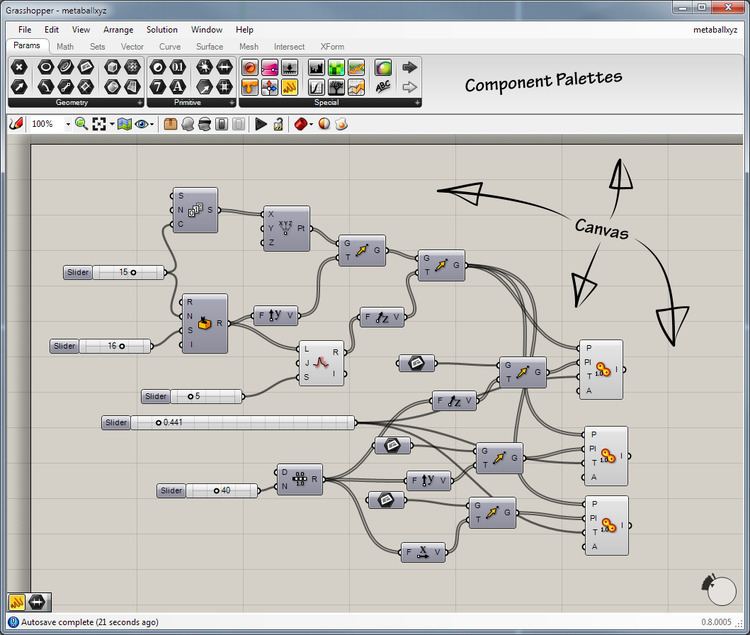Type Visual Programming | ||
 | ||
Developer(s) Robert McNeel & Associates Initial release September 2007; 9 years ago (2007-09) Stable release 1.0 / April 4, 2014; 2 years ago (2014-04-04) Operating system | ||
Grasshopper is a visual programming language and environment developed by David Rutten at Robert McNeel & Associates, that runs within the Rhinoceros 3D computer-aided design (CAD) application. Programs are created by dragging components onto a canvas. The outputs to these components are then connected to the inputs of subsequent components.
Contents
Grasshopper is primarily used to build generative algorithms, such as for generative art. Many of Grasshopper's components create 3D geometry. Programs may also contain other types of algorithms including numeric, textual, audio-visual and haptic applications.
Advanced uses of Grasshopper include parametric modelling for structural engineering, parametric modelling for architecture and fabrication, computational Japanese garden design, lighting performance analysis for eco-friendly architecture and building energy consumption.
The first version of Grasshopper was released in September 2007, and titled Explicit History. Grasshopper has become part of the standard Rhino toolset in Rhino 6.0 and later.
AEC Magazine stated that Grasshopper is "Popular among students and professionals, McNeel Associate’s Rhino modelling tool is endemic in the architectural design world. The new Grasshopper environment provides an intuitive way to explore designs without having to learn to script."
User Interface
Grasshopper features an advanced user interface. The main window consist mainly of the component 'palettes' and the 'canvas'. Since Grasshopper is a plug-in to Rhinoceros 3D, the layout of the main window is kept minimal.
GUI elements include:
Node based editor
The main interface for algorithm design in Grasshopper is the node-based editor. Data is passed from component to component via connecting wires which always connect an output grip with an input grip. Data can either be defined locally as a constant, or it can be imported from the Rhino document or a file on the computer. Data is always stored in parameters, which can either be free-floating or attached to a component as input and outputs objects.
In the image above we see three free-floating parameters that are hooked up to a subtraction component. The two yellow boxes on the left both define a set of numeric constants. The top-most panel contains four integers (6, 7, 8 and 12) while the bottom-most panel contains only a single value. These floating parameters supply the subtraction component with input data, which results in four output values (6-5=1, 7-5=2, 8-5=3 and 12-5=7). The same result can be achieved using textual expressions and an evaluator component. In this fashion Grasshopper allows users to combine both visual and textual programming within the same environment.
